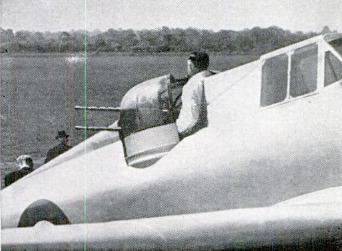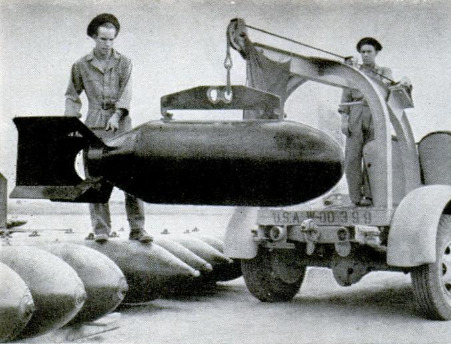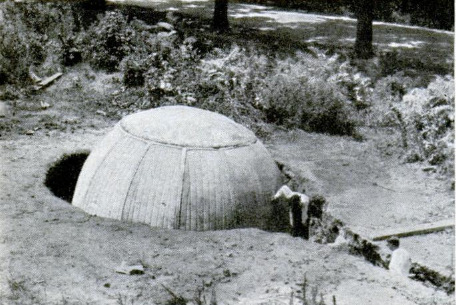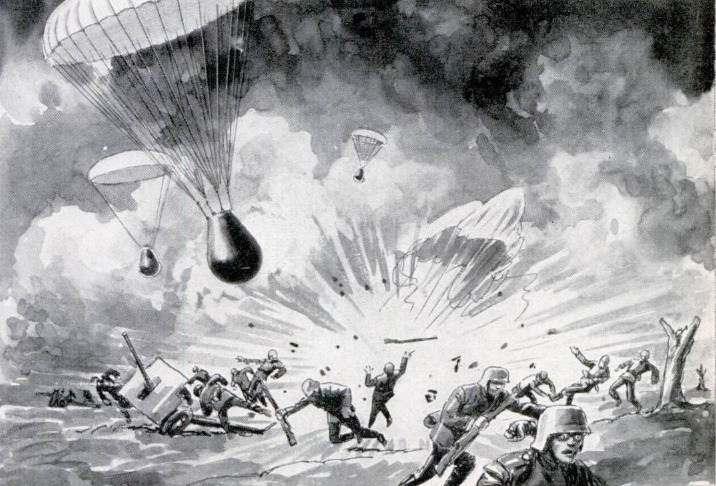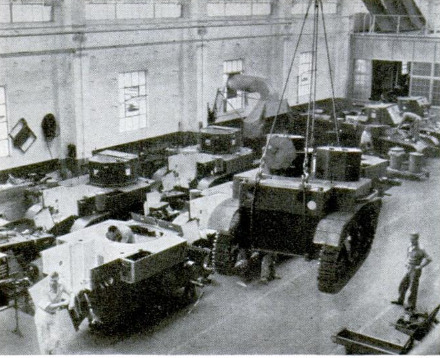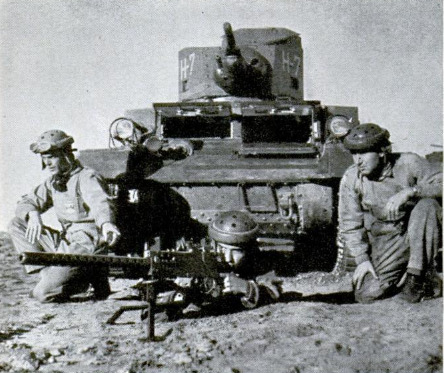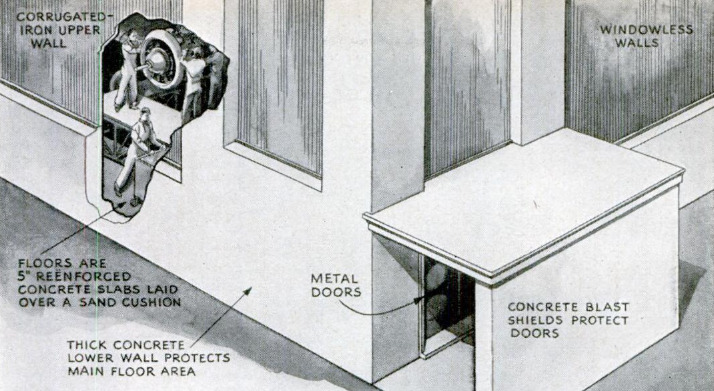-
Title (Dublin Core)
-
What has America learned from the war
-
Article Title and/or Image Caption (Dublin Core)
-
Title: What has America learned from the war
-
extracted text (Extract Text)
-
BOUT the busiest students in the United
A States now are the officers of the
‘Army and Navy. The battleground of |
Europe is their university. Like other tech-
nicians, they have to keep learning as they |
go, and they learn best by experience.
Now, if you are running a subway, you |
are running it all the time, but if you are |
in the military profession you have to wait |
for a war. After all the studying of past
wars, after all the planning and preparing, |
you still have to learn by fighting—either
your own or somebody else's. Somebody
else’s is less expensive.
The general lessons of the present and |
recent European campaigns are not new, |
but they bring out new phases of principles
which were known to all educated soldiers.
One is the vital necessity of close cobrdina- |
tion of all branches, under unified command. |
If there was any miracle about the victories
in Norway and Flanders, is was in the skill |
with which the Germans welded their |
specialized arms into a single fighting
machine. It was a remarkable demonstra-
tion of teamwork in combat against op-
ponents who were not prepared and drilled
in anything like the same degree. The
results were conclusive.
It was not solely a triumph of machines.
Mechanization is extremely important, but |
everything depends on the manner in which
the forces are used. The rout of the
mechanized Italian forces at Guadalajara in |
the Spanish war by relatively unmechanized
troops (an episode repeated with variations
early in the Greek campaign) shows that
machines as such do not win a war. Ma-
chines magnify both striking power and
vulnerability. On the wrong terrain or in
bad weather, or under bad leadership, a
mechanized army can be led into disaster
faster than one equipped only with the
traditional arms.
The “secret” of the effective use of
mechanized ground forces lies in finding a
weak spot and hitting it for all it is worth.
The principle is older than mechanization;
Sheridan used it in the Civil War with
cavalry. He massed his cavalry in one place
and broke through, and he had the knack of
picking the right place. Before his time
the tendency was to distribute cavalry along
a wide front, just as the British and French
mistakenly used their tanks and other
mechanized units in the present war.
For all their stress on mechanization, the
Germans had nine or ten infantry divisions
for every “panzer” division. When they
achieved a break-through they had the
necessary infantry power to keep and ex-
tend the opening. The mechanized forces,
once they got through, were able to work
havoc behind the enemy lines, for they
were virtually self-sufficient, forced neither
to return to their bases for supplies nor to
rely on communication lines. The necessity
for self-sufficiency of fast-moving mecha-
nized forces is one of the important practical
lessons from what happened in France.
Aside from such general conclusions as
these, there are indications that the func-
tions of some of the arms will be different
in the future. One factor about which
American soldiers are speculating is the
use of the engineers as a combat arm.
Of course, engineers have always been
prepared to fight, although their primary
function is to make routes passable for
their own forces and impassable for the
enemy. The Germans, however, used en-
gineers deliberately for some of their
toughest fighting — substantially as shock
troops. The invasion of Belgium was led
by a battalion of engineers, and fortifica-
tions such as the Belgian Eben Emael,
which were virtually invulnerable to artil-
lery fire, were reduced by engineer combat
units with explosives. Besides explosives in
great quantities, these engineers carried
rifles, machine guns, hand grenades, flame
throwers, scaling ladders, crowbars, long
poles, smoke candles, and about every other
portable assault weapon that can be im-
agined. They closed in by taking advantage
of shell craters which the artillery made
for them. The occupants of the fort were
unable to reply effectively because the
German artillery kept up a continuous fire
on the ports and turrets. Finally the en-
gineers were able to get right up against the
walls of tae fortress and to blow up turrets
and doors with planted explosives.
Next to the airplane, the tank is the
chief new weapon both of the first World
War and the present one. And as far as
this war is concerned, the heavy tank is
the one to watch, not the light tank. One
military observer remarks that
the effectiveness of the heavy
tank as a break-through
weapon was something of a
surprise to soldiers as well as
to civilians. Except for Ger-
many, he says, after the last
war the nations deluded them-
selves into the belief that
swarms of tankettes would be
effective for open warfare, and
this while they were building
fortifications such as the Ma-
ginot Line, the Mannerheim
Line, and the Crech Sudeten-
land forts, against which light
tanks had about as much
chance as a tack hammer
against a bank vault.
This commentator believes
that the Russians could have
breached the Mannerhelm Line
at considerably lower cost with
large tanks than with the
artillery, planes, and masses
of men they eventually used.
They started with thin-skinned
‘medium-weight tanks, which
proved ineffective. In con.
trast, the Germans on the
Western Front relied on
heavily armored tanks from
the outset. According to one
report, these tanks weighed 70
tons aplece and were armed
with 77-mm. or 156-mm. can-
non, and flame throwers. The
Germans have not provided
samples, and one can only
speculate as to the actual
weight and armament of these
machines. The only thing
cortain is that they were
heavy and numerous enough to
{achieve the objective, and that
they were fast for their size. Weight alone
was not a determining factor. It is known
that the French threw into the action some
twenty 70-ton tanks of an obsolete design,
and these were hopelessly ineffective against
the faster German machines.
The monster tank has two missions (mili-
tary men are fond of that word)—to break
through, and to repel enemy tanks. It has
to be as agile as its size will permit, climb
well, and span broad ditches. It must be
heavily armored, since antitank artillery is
constantly increasing in effectiveness, and
calibers as high as 75 mm. may be used
against it. Its own armament depends on
its purpose. Against ordinary fortifications
it may carry two or more 75 mm. or 165-
mm. cannon. For close-in protection and
against infantry, it uses machine guns. In
addition to this arsenal, it has need for an
antiaircraft gun as well,
Naturally, it is not an extremely fast
machine. Small tanks are fast, and if out-
gunned they can always make a run for it.
The heavy tank must shoot its way out.
But that is a slight disadvantage. The chief
trouble with these heavy tanks is in trans-
porting them before they go into battle.
Since few highway bridges can sustain their
weight, they must travel by rail. That lim-
its their width in most countries to 10 feet
4 inches, and height to 14 feet 5 inches
above the rails. They can be carried on flat
cars if their weight is not over 80 tons, but
a better method is to equip them with rail
trucks which are a part of the tank itself,
s0 that several can be drawn in tandem by
one locomotive, or they can move on rails
under their own power.
An example of the adaptation of old
weapons to new conditions under stress of
necessity is the use of the 75-mm. gun
against tanks by the French. Since a tank
is fairly fast, it is necessary to swivel the
plece rapidly to keep up with the target.
All that this involves is the addition of a
circular metal platform with six-inch metal
prongs on the under side. This is carried
separately on a caisson. To operate against
tanks, the crew throws the platform on the
ground and jumps on it to imbed the prongs.
On its upper surface the platform has a
flange which forms a circular track for the
wheels of the gun. The trail is shifted by
one or two members of the crew. Used in
this way, the 75-mm. gun did fairly effective
work as a substitute for the standard
47-mm. A. T. gun, with which the French
were none too well equipped. It was no
more than an improvisation, but one of
some interest to the military student.
The United States has no big tanks on
hand, but it is understood that a heavily
armored model of 50 or 60 tons is about
ready for field testing. The fact that we do
not have hundreds or thousands of such
Juggernauts ready to go into action is no
cause for alarm. The likelihood of our need-
ing them for use at home is extremely re-
mote. If they should ever be called on, the
Army will have them and know how to use
them. It has kept abreast of military de-
velopments all over the world and has never
subscribed to the now discredited theory
that tanks and other mechanized units
should be “encadred” within larger units.
Our tacticians favored the independent,
synchronized-action method before it was
proved in the field by the Germans, and it
is being taken into full account.
The performance of American aircraft in
England recently has been severely crit
icized. These criticisms, in so far as they
relate to models supplied during 1940, are
in large part justified. The planes that have
gone over have been fast, highly maneuver-
able, and well built, but most of them
have been underarmored and undergunned,
sometimes complex in operation, and not
equipped with important accessories of
modern aerial warfare such as self-sealing
fuel and ofl tanks.
I. should be realized, however, that every
new model of anything, whether it is a
radio receiver or a milk can or an airplane,
is found to have things the
matter with it when it gets
into the field. That is bound to
be doubly true of such a com-
plex, nervous, and changeable
business as air fighting. Many
basic questions of aircraft de-
sign are not yet settled. Take
the matter of the air-cooled
radial engine and the liquid-
cooled engine. The British pre-
fer the latter for pursuit
planes, but there are plenty of
arguments on the other side.
The air-cooled motor is being
produced in quantities; it is
the type used by the commer-
cial airlines. It warms up
faster—any motorist can ap-
preciate what that means in
dependability—and by the
same token it has a longer
life. It is lighter. The fire
hazard is slighter. There is
no danger of loss of cooling
fluid through gunfire. All
these considerations may now
have to go by the board as far
as pursuit planes are con-
cerned, but the probability is
that both air-cooled and liquid-
cooled motors will continue to
be used to power military air-
planes.
One other point should be
noted. The planes on which
the United States relies fcr
immediate protection, especial-
ly the naval types, are highly
satisfactory for the purpose
for which they were designed.
The air defense of the United
States relies primarily on the
bomber. The pursuit ship plays
a secondary part. Pursuit and
interception are of far more
importance to the British than
to us. One experienced Ameri-
can Army officer sums up the
situation as follows: “It must
be remembered that the defense of the
British Isles is actually a ‘special opera-
tion.” American planes were not designed
for this. Our large-view problem of military
aircraft is quite different from the pressing
situation in which the British now find
themselves, and it would be a grave mistake
to base design entirely on the momentary
needs in the defense of the British Isles.”
None of this alters the fact that with the
information now coming over from England
the United States will make as much prog-
ress in combat-plane design in a year as
in two or three years of normal develop-
ment. The same is true of the operation
of fighting planes. The power-driven gun-
turret is a case in point. A turret in an
airplane is a kind of universal joint which
permits aiming guns in almost any direc-
tion. The United States had several types
under development before the question of
aid to Britain came up. But the British tur-
ret which became available to American
designers in October, 1940, is very good,
the result of several years of experimenta-
tion, and no doubt it will influence the de-
sign of American turrets. It is hydrauli-
cally operated. There are also pneumati-
cally, electrically, and manually operated
turrets. One thing that should be guarded
against is the installation of more than one
type in a given plane. Maintenance diffi-
culties are quite enough without mixing up
several types of mechanism for the same
Job.
One advantage, from a military stand-
point, of the present tie-up between British
and American aircraft technicians is that
our people get accurate information on Ger-
man types. German planes brought down in
England can sometimes be repaired and
flown almost with their original perform-
ance characteristics. What is perhaps even
more important, the results of large-scale
air fighting can be obtained for the develop-
ment of American aircraft. Finally, some
idea can be had of what the Germans are
going to spring in their new models.
One of the best of their current types is
the Messerschmitt 110. Its design and per-
formance are now accurately known, since
the British have several of them. It is an
all-metal piane powered by two 1,150 h.p.
motors, liquid-cooled. The speed is 365
m.p.h. at 19,000 feet. It mounts five machine
guns and two 20-mm. cannon. None of these
fires through the airscrew disk, so that
there is mo limitation of the rate of fire
on that account. All the forward armament
is concentrated in the nose—four of the
machine guns and both of the cannon. The
fifth machine gun covers a 120-degree arc
rearwards. There is a long-range version
of this model which dispenses with the can-
non; this is the one which has been ex-
tensively used for bombing as well as for
escort and pursuit. It can carry two 550-
pound bombs in the center section.
The results of air fighting to date indicate
that the smallest gun which can damage a
plane seriously is the .50 caliber size. Rifle-
caliber bullets are effective only against
personnel, and as armor protection im-
proves it becomes more and more neces-
sary to damage the plane rather than its
occupants. There
have been innumerable cases of planes re-
turning in flyable condition full of .30-
caliber holes. One explosive bullet or small
shell is more effective than a barrage of
nonexplosive projectiles.
Some British commentators think ill of
four-engine bombers. They assert that the
four-engine type was based on peacetime
theories and that a year of war has drasti-
cally modified the requirements—which
would of course apply to their Sunderlands
as much as to our Boeing B-17s. This school
of thought prefers smaller, faster bombers
which can be used in daylight. However,
the reports on the B-24 (Consolidated
Model 32) are rather favorable. This car-
ries four 1,200 hp. Pratt and Whitney
Wasps and has a top speed of 300 m.p.h.
It has British turrets in nose and tail.
An item of interest to those who would
like to see more experimentation with trans-
ports converted into bombers is the excep-
tionally favorable report on the Lockheed
Hudson, which is a converted airliner. The
undercarriage is said to be weak, but this
model has fought off and shot down Hein-
kel HE-115 seaplanes and Messerschmitt
110s. It has been used more for reconnais-
sance than for bombing, but so far it seems
to be one of the most useful types we
have sent over.
‘The British predict that eventually all
fighters will be equipped with turrets. They
favor two-seater fighters, especially for
night worl; it is becoming increasingly dif-
ficult for one man to do both the fighting
and the piloting. They expect that future
day bombers will have fighter performance
and little or no armament. “If there is
fighting to be done, its escort will have to
do it,” one writer predicts. “The part of the
bomber will be simply to bomb and run.”
There are many serious problems of mass
production of military implements which
have not been solved. In design, also, mis-
takes have been made, and there is no
guaranty that they will not be made in
the future. All that can be said for the
technicians is that they learn from their
mistakes rather quickly and don’t keep on
making the same ones over and over, as is
the rule in some. other lines of human en-
deavor. No nation has a monopoly on tech-
nical skill; they are all exporters and im-
porters. But we may be sure that our
technicians, adding what they are getting
from abroad to their own endowments, will
give a good account of themselves.
-
Contributor (Dublin Core)
-
Carl Dreher (article writer)
-
Language (Dublin Core)
-
Eng
-
Date Issued (Dublin Core)
-
1941-04
-
pages (Bibliographic Ontology)
-
55-59, 220
-
Rights (Dublin Core)
-
Public domain
-
Archived by (Dublin Core)
-
Sami Akbiyik
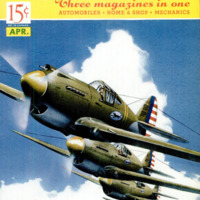 Popular Science Monthly, v. 138, n. 4, 1941
Popular Science Monthly, v. 138, n. 4, 1941

